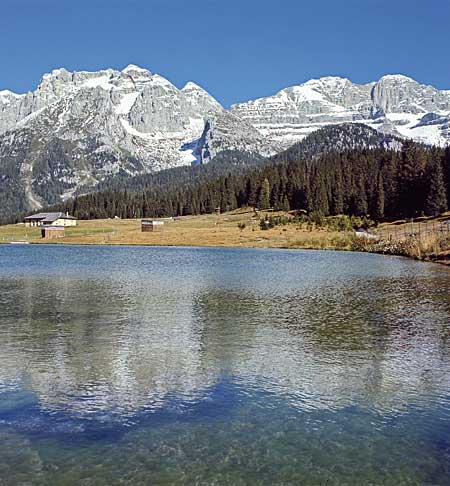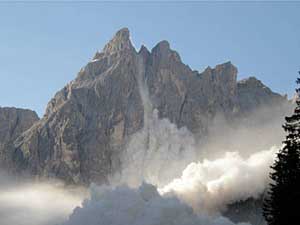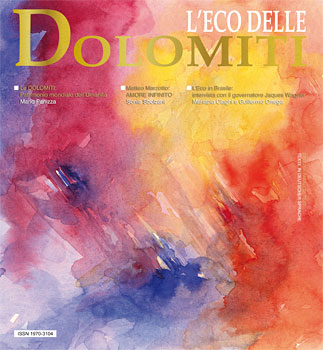The DOLOMITES:
UNESCO world heritage site
Prof. Mario Panizza
(Università di Modena e Reggio Emilia)

In a meeting held in Seville between 22 and 30 June 2009 the UNESCO World Heritage Committee proclaimed the Dolomites mountain range as a “World Heritage Site”, with the motivation that the range presents one of the most spectacular and representative mountain landscapes in the world. In fact, the range has been included in the list of natural heritage under the double criterion of exceptional natural beauty and aesthetic importance and that of significant geomorphic or physiographic features. The lengthy course of the official nomination process initiated in 2005, following the petitions made by national and local environmental associations since the first half of the 1990s, therefore resulted in the best possible outcome.
 The nomination dossier was prepared by architect Cesare Micheletti for the criteria of natural beauty/aesthetic importance, Professor Piero Gianolla for the geological criteria and by the undersigned Professor Mario Panizza for the geomorphic criteria. The nomination dossier was prepared by architect Cesare Micheletti for the criteria of natural beauty/aesthetic importance, Professor Piero Gianolla for the geological criteria and by the undersigned Professor Mario Panizza for the geomorphic criteria.
Out of the Dolomite range, nine different “systems” were chosen to represent an organic “series” of exceptional aesthetic and scientific value. The nine systems, found in the provinces of Belluno, Bolzano, Pordenone, Trento and Udine, are integrated and complementary, providing an overview of a group of extraordinary mountains, unique landscapes created from rocks and relief forms which tell the wonderful tale of a long interval in the history of the Earth and illustrate globally important geological and geomorphic processes.
 From a landscape point of view these mountains present exceptional monumental, original and spectacular features. It is here that 19th century travellers found inspiration for the “romantic” landscape, and they still provide a fundamental reference point for defining the modern concept of natural beauty. We should remember the painters who have been inspired by these mountains for their works: from Titian to the romantics, from the expressionists to the futurists and onwards to contemporary artists, in addition to writers, poets and other artists who have felt stimulated and called to immortalise the aesthetic suggestions of this range. From a landscape point of view these mountains present exceptional monumental, original and spectacular features. It is here that 19th century travellers found inspiration for the “romantic” landscape, and they still provide a fundamental reference point for defining the modern concept of natural beauty. We should remember the painters who have been inspired by these mountains for their works: from Titian to the romantics, from the expressionists to the futurists and onwards to contemporary artists, in addition to writers, poets and other artists who have felt stimulated and called to immortalise the aesthetic suggestions of this range.
The geological importance of the Dolomites is due to the extremely detailed and continuous manner in which they represent a large part of the Mesozoic Era, bearing witness to a tropical sea which existed here between 260 and 200 million years ago. It is possible to reconstruct the geo-history of this period as if reading from the pages of a gigantic stone book, walking on ancient lagoons and visiting the margin with the remains of coral and sponges before descending the age-old slopes to reach the bottom of ancient oceans. You can map out the succession of ancient cliff faces in space and time, or assist at volcanic eruptions and discover the evolution of various forms of life from shellfish to dinosaurs.
 From a geomorphic point of view, they provide a wide and exemplary case study into a range of phenomena, thanks to their complex geological structure and the current and past climatic conditions: towers, spires, pinnacles and calcareous or dolomitic slopes, mountain ranges and buttresses of volcanic rock, gentle slopes of clay soil, detrital layers and cones, maceral rockslides, plateaus, lakes, and torrential gulleys, etc. We can also observe vestiges from the pre-glacial and interglacial eras right up to the present day, along with, above all, forms of erosion and accumulation from ancient glaciers. These glaciers, measuring more than a thousand metres high, occupied the valleys of the Dolomites until only a few thousand years ago, leaving only the highest peaks emerging and reaching as far as the edge of the Po Plain. From a geomorphic point of view, they provide a wide and exemplary case study into a range of phenomena, thanks to their complex geological structure and the current and past climatic conditions: towers, spires, pinnacles and calcareous or dolomitic slopes, mountain ranges and buttresses of volcanic rock, gentle slopes of clay soil, detrital layers and cones, maceral rockslides, plateaus, lakes, and torrential gulleys, etc. We can also observe vestiges from the pre-glacial and interglacial eras right up to the present day, along with, above all, forms of erosion and accumulation from ancient glaciers. These glaciers, measuring more than a thousand metres high, occupied the valleys of the Dolomites until only a few thousand years ago, leaving only the highest peaks emerging and reaching as far as the edge of the Po Plain.
In conclusion, we can assert that the Dolomites represent a kind of high altitude, open air laboratory of a geological and geomorphic heritage of exceptional global value, among the most extraordinary and accessible in the world and ideal for researching, teaching, understanding and developing Earth Science theories.
 The value of the Dolomites is also demonstrated by the interest which these mountains have always inspired in Earth Science experts; in fact, pioneering studies in stratigraphy, mineralogy, sedimentology, palaeontology and geomorphology have been conducted in the Dolomites by eminent Italian and international geologists since the 18th century. This interest for the Dolomites is documented by the numerous scientific publications about them, from the great number of researchers all over the world who continue to visit them and the numerous students who choose them as the subject of their theses and doctorates. The value of the Dolomites is also demonstrated by the interest which these mountains have always inspired in Earth Science experts; in fact, pioneering studies in stratigraphy, mineralogy, sedimentology, palaeontology and geomorphology have been conducted in the Dolomites by eminent Italian and international geologists since the 18th century. This interest for the Dolomites is documented by the numerous scientific publications about them, from the great number of researchers all over the world who continue to visit them and the numerous students who choose them as the subject of their theses and doctorates.
The UNESCO list includes approximately 900 sites distributed over 148 countries all over the world. The recognition of the Dolomites will integrate the list of Italian “cultural world heritage”: 42 sites, of which the Aeolian Islands and the Dolomites are the only two “natural” examples. Furthermore, their listing as “serial heritage sites” constitutes a type of model for the nomination of several sites (even cross-border sites) and their management in a coordinated and integrated system.
|
 NUMBER 9
NUMBER 9


 The nomination dossier was prepared by architect Cesare Micheletti for the criteria of natural beauty/aesthetic importance, Professor Piero Gianolla for the geological criteria and by the undersigned Professor Mario Panizza for the geomorphic criteria.
The nomination dossier was prepared by architect Cesare Micheletti for the criteria of natural beauty/aesthetic importance, Professor Piero Gianolla for the geological criteria and by the undersigned Professor Mario Panizza for the geomorphic criteria.  From a landscape point of view these mountains present exceptional monumental, original and spectacular features. It is here that 19th century travellers found inspiration for the “romantic” landscape, and they still provide a fundamental reference point for defining the modern concept of natural beauty. We should remember the painters who have been inspired by these mountains for their works: from Titian to the romantics, from the expressionists to the futurists and onwards to contemporary artists, in addition to writers, poets and other artists who have felt stimulated and called to immortalise the aesthetic suggestions of this range.
From a landscape point of view these mountains present exceptional monumental, original and spectacular features. It is here that 19th century travellers found inspiration for the “romantic” landscape, and they still provide a fundamental reference point for defining the modern concept of natural beauty. We should remember the painters who have been inspired by these mountains for their works: from Titian to the romantics, from the expressionists to the futurists and onwards to contemporary artists, in addition to writers, poets and other artists who have felt stimulated and called to immortalise the aesthetic suggestions of this range.  From a geomorphic point of view, they provide a wide and exemplary case study into a range of phenomena, thanks to their complex geological structure and the current and past climatic conditions: towers, spires, pinnacles and calcareous or dolomitic slopes, mountain ranges and buttresses of volcanic rock, gentle slopes of clay soil, detrital layers and cones, maceral rockslides, plateaus, lakes, and torrential gulleys, etc. We can also observe vestiges from the pre-glacial and interglacial eras right up to the present day, along with, above all, forms of erosion and accumulation from ancient glaciers. These glaciers, measuring more than a thousand metres high, occupied the valleys of the Dolomites until only a few thousand years ago, leaving only the highest peaks emerging and reaching as far as the edge of the Po Plain.
From a geomorphic point of view, they provide a wide and exemplary case study into a range of phenomena, thanks to their complex geological structure and the current and past climatic conditions: towers, spires, pinnacles and calcareous or dolomitic slopes, mountain ranges and buttresses of volcanic rock, gentle slopes of clay soil, detrital layers and cones, maceral rockslides, plateaus, lakes, and torrential gulleys, etc. We can also observe vestiges from the pre-glacial and interglacial eras right up to the present day, along with, above all, forms of erosion and accumulation from ancient glaciers. These glaciers, measuring more than a thousand metres high, occupied the valleys of the Dolomites until only a few thousand years ago, leaving only the highest peaks emerging and reaching as far as the edge of the Po Plain.  The value of the Dolomites is also demonstrated by the interest which these mountains have always inspired in Earth Science experts; in fact, pioneering studies in stratigraphy, mineralogy, sedimentology, palaeontology and geomorphology have been conducted in the Dolomites by eminent Italian and international geologists since the 18th century. This interest for the Dolomites is documented by the numerous scientific publications about them, from the great number of researchers all over the world who continue to visit them and the numerous students who choose them as the subject of their theses and doctorates.
The value of the Dolomites is also demonstrated by the interest which these mountains have always inspired in Earth Science experts; in fact, pioneering studies in stratigraphy, mineralogy, sedimentology, palaeontology and geomorphology have been conducted in the Dolomites by eminent Italian and international geologists since the 18th century. This interest for the Dolomites is documented by the numerous scientific publications about them, from the great number of researchers all over the world who continue to visit them and the numerous students who choose them as the subject of their theses and doctorates.